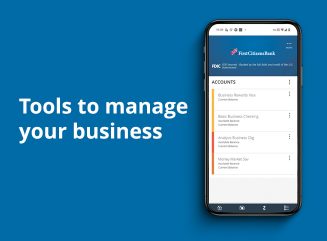Digital banking for business
Seamlessly access all of your accounts from one place with First Citizens Digital Banking for business.

Invest how you want, when you want, in real time with Self-Directed Investing.

Seamlessly access all of your accounts from one place with First Citizens Digital Banking for business.
We're committed to serving companies as they expand and succeed. The proof is in our success stories.
November Market Update video: Available now
Phillip and Blake take a deep dive into key issues for markets and the economy as we enter the holiday season.

Hank Dunbar
Senior Vice President | Philanthropic and Charitable Strategist
The end of the year is a season when generosity often comes to the forefront. It's a time when many people look for ways to give back, support those in need and contribute to the causes and charities close to their hearts.

While there are many ways to achieve your charitable giving goals, adopting a more strategic approach to year-end giving can help maximize your philanthropic impact and enhance any potential tax benefits.
Many people give their resources to a number of different charities, often in response to a direct request. While this type of giving can serve a good purpose, adding structure to your charitable giving strategy and thinking long term can create better outcomes for both you and the organizations you support.
Setting annual donation goals, giving throughout the year and choosing the right donation structure are just a few smart ways to make your charitable giving strategy more effective.
Discover five additional strategies in the video below, and consider incorporating them into your philanthropic financial plan.
First Citizens Wealth™
Hank Dunbar, Manager of Philanthropic and Charitable Services
Making strategic choices about how you can give can help you make the most of your contributions, and it can boost your tax savings.
5 Ways to Maximize Your Charitable Giving
We've put together five strategies that can help individuals take their personal giving to the next level.
1 Establish goals
The first one is to establish goals. Identify the causes you care most about, identifying charities that focus on your priorities by talking to your friends or by talking to your family members, and then doing some research on your own.
2 Conduct research
Go to Charity Navigator or GuideStar. Nonprofits are very public entities, so you can look at a 990 or a 990 PF return on foundations, nonprofit organizations in general, and see how they use the money that's given them.
3 Create a giving plan
So once you've identified your favorite causes, the things that you really are passionate about, you want to create a giving plan. Choose one or two charities—don't try to shotgun it at first, but really give it a focused approach—that align with your values, and consider what you want to achieve when you are working with those charities. Decide how your donations are going to be used. Decide how much you want to contribute. And think about how often you want to give.
4 Consult your advisors
This is something you really need to have a serious conversation with your advisor on. Your financial advisor, the person who helps you understand what your assets are—the nature of your assets and the value of your assets. And the other person is your tax planner, your CPA. You and those two people together form the team that decides how much to give and what to give. They can help you find a level of giving that's appropriate for your circumstances and that you can be comfortable with, and they can also help you plan for the future in other ways.
5 Engage your family
It's also a great time to engage your children, especially when they're young, in the giving process. That whole concept is just a really good way of establishing a legacy of philanthropy in your family.
For more, visit FirstCitizens.com/Wealth.
First Citizens Wealth™
This material is for informational purposes only and is not intended to be an offer, specific investment strategy, recommendation or solicitation to purchase or sell any security or insurance product, and should not be construed as legal, tax or accounting advice. Please consult with your legal or tax advisor regarding the particular facts and circumstances of your situation prior to making any financial decision. While we believe that the information presented is from reliable sources, we do not represent, warrant or guarantee that it is accurate or complete.
Your investments in securities and insurance products and services are not insured by the FDIC or any other federal government agency and may lose value. They are not deposits or other obligations of, or guaranteed by any bank or bank affiliate and are subject to investment risks, including possible loss of the principal amounts invested.
About the Entities, Brands and Services Offered: First Citizens Wealth™ (FCW) is a marketing brand of First Citizens BancShares, Inc., a bank holding company. The following affiliates of First Citizens BancShares are the entities through which FCW products are offered. Brokerage products and services are offered through First Citizens Investor Services, Inc. ("FCIS"), a registered broker-dealer, Member FINRA and SIPC. Advisory services are offered through FCIS, First Citizens Asset Management, Inc. and SVB Wealth LLC, all SEC registered investment advisors. Certain brokerage and advisory products and services may not be available from all investment professionals, in all jurisdictions or to all investors. Insurance products and services are offered through FCIS, a licensed insurance agency. Banking, lending, trust products and services, and certain insurance products and services are offered by First-Citizens Bank & Trust Company, Member FDIC, and an Equal Housing Lender, and SVB, a division of First-Citizens Bank & Trust Company. icon: sys-ehl
All loans provided by First-Citizens Bank & Trust Company and Silicon Valley Bank are subject to underwriting, credit and collateral approval. Financing availability may vary by state. Restrictions may apply. All information contained herein is for informational purposes only and no guarantee is expressed or implied. Rates, terms, programs and underwriting policies are subject to change without notice. This is not a commitment to lend. Terms and conditions apply. NMLSR ID 503941
For more information about FCIS, FCAM or SVBW and its investment professionals, click the links below:
FirstCitizens.com/Wealth/Disclosures
SVB.com/Private-Bank/Disclosures/Form-ADV
©2024 First-Citizens Bank & Trust Company. All rights reserved. Silicon Valley Bank, a division of First-Citizens Bank & Trust Company. Member FDIC., First Citizens Wealth is a trademark of First Citizens Bancshares, Inc.
The views expressed are solely those of the authors and do not necessarily reflect the views of First-Citizens Bank & Trust Company or any of its affiliates. Companies listed are independent third parties and are not affiliated with First-Citizens Bank and Trust Company. All third-party trademarks (including logos, trade names, service marks, and icons) referenced herein remain the property of their respective owners.
In addition to supporting worthy organizations, charitable contributions may provide meaningful tax benefits. Many taxpayers are eligible to deduct donations made to qualified charities, reducing their taxable income.
As of 2025, the IRS allows taxpayers who itemize to deduct up to 60% of their adjusted gross income, or AGI, for cash donations and up to 30% of AGI for noncash assets. While these limits were set to expire at the end of this year, the One Big Beautiful Bill Act, or OBBBA, has made them permanent.
The OBBBA has introduced several other changes that may shape your year-end charitable giving strategy for 2025. The following changes will go into effect starting in 2026:
In light of these changes, some high-income donors may wish to accelerate their charitable giving in 2025. Review the OBBBA's changes to charitable deductions to help you determine the best approach for your goals.
As you review your charitable giving strategy, be sure to connect with your tax advisor and financial team. They can help you assess your philanthropic goals, review any potential tax impacts and ensure your charitable giving strategy works in tandem with your overall wealth strategy.
Amplify your end-of-year giving with a First Citizens Donor Advised Fund.



Hank Dunbar
Senior Vice President | Philanthropic and Charitable Strategist


George Burnette
JD, CFP, ATFA, TEP VP, Philanthropic & Charitable Strategist
Links to third-party websites may have a privacy policy different from First Citizens Bank and may provide less security than this website. First Citizens Bank and its affiliates are not responsible for the products, services and content on any third-party website.
This material is for informational purposes only and is not intended to be an offer, specific investment strategy, recommendation or solicitation to purchase or sell any security or insurance product, and should not be construed as legal, tax or accounting advice. Please consult with your legal or tax advisor regarding the particular facts and circumstances of your situation prior to making any financial decision. While we believe that the information presented is from reliable sources, we do not represent, warrant or guarantee that it is accurate or complete.
Third parties mentioned are not affiliated with First-Citizens Bank & Trust Company.
Your investments in securities and insurance products and services are not insured by the FDIC or any other federal government agency and may lose value. They are not deposits or other obligations of, or guaranteed by any bank or bank affiliate and are subject to investment risks, including possible loss of the principal amounts invested. There is no guarantee that a strategy will achieve its objective.
About the Entities, Brands and Services Offered: First Citizens Wealth® (FCW) is a registered trademark of First Citizens BancShares, Inc., a bank holding company. The following affiliates of First Citizens BancShares are the entities through which FCW products are offered. Brokerage products and services are offered through First Citizens Investor Services, Inc. ("FCIS"), a registered broker-dealer, Member FINRA and SIPC. Advisory services are offered through FCIS, First Citizens Asset Management, Inc. and SVB Wealth LLC, all SEC registered investment advisors. Certain brokerage and advisory products and services may not be available from all investment professionals, in all jurisdictions or to all investors. Insurance products and services are offered through FCIS, a licensed insurance agency. Banking, lending, trust products and services, and certain insurance products and services are offered by First-Citizens Bank & Trust Company, Member FDIC and an Equal Housing Lender icon: sys-ehl, and First Citizens Delaware Trust Company.
All loans provided by First-Citizens Bank & Trust Company and Silicon Valley Bank are subject to underwriting, credit and collateral approval. Financing availability may vary by state. Restrictions may apply. All information contained herein is for informational purposes only and no guarantee is expressed or implied. Rates, terms, programs and underwriting policies are subject to change without notice. This is not a commitment to lend. Terms and conditions apply. NMLSR ID 503941
For more information about FCIS, FCAM or SVBW and its investment professionals, visit FirstCitizens.com/Wealth/Disclosures.
See more about First Citizens Investor Services, Inc. and our investment professionals at FINRA BrokerCheck.

Treasury & Cash Management
Electronic Bill Presentment & Payment
Investment & Retirement Services
Community Association Banking
Equipment Financing & Leasing
Credit Cards
Merchant Services
Email Us
Please select the option that best matches your needs.
Customers with account-related questions who aren't enrolled in Digital Banking or who would prefer to talk with someone can call us directly.